Who Was Quang Trung and the Tay Son Uprising?
Quang Trung (Nguyen Hue)
Nguyen Hue, later known as Emperor Quang Trung, is remembered as one of Vietnam’s greatest military leaders. Rising from humble origins in Binh Dinh, he gained fame for his strategic brilliance and ability to inspire large numbers of farmers and soldiers.

His most celebrated achievement was the victory over the Qing army in 1789, when his forces marched from central Vietnam to Hanoi in just a few days, defeating an army many times larger. Beyond military success, he worked to unify Vietnam, standardize administration, and strengthen national independence during a turbulent period.
The Tay Son Brothers and Their Uprising
Quang Trung was one of three brothers—Nguyen Nhac, Nguyen Lu, and Nguyen Hue—who launched the Tay Son uprising in the late 18th century. What began as a peasant rebellion against corrupt local rulers quickly grew into a national movement. Their army managed to overthrow both the Trinh and Nguyen lords, who had divided Vietnam for centuries, and later challenged foreign invaders. The Tay Son brothers became symbols of resilience, social justice, and national unity, though their rule was short-lived after Quang Trung’s death in 1792.
Legacy in Binh Dinh and Vietnam Today
For locals in Binh Dinh, the Tay Son brothers are more than historical figures—they are hometown heroes. The Quang Trung Museum was built in their native village to preserve this legacy and give future generations a place to learn about the movement. For Vietnam as a whole, Quang Trung represents strength, independence, and the possibility of social change led from below. This background helps explain why the museum is such an important cultural landmark, even if it doesn’t always match the grandeur of bigger national museums in Hanoi or Ho Chi Minh City.
What is there to see inside the Exhibition Halls
The main draw of Quang Trung Museum is its large exhibition area. Spread over nine galleries, it holds more than 11,000 objects from the Tay Son period. The collections are arranged thematically, covering the story of the brothers’ rise, their military victories, their short-lived dynasty, and even the everyday life of people in 18th-century Vietnam. Not everything is labeled in English, but with some context in mind, it’s an impressive collection that feels more substantial than most provincial museums.
1. From origins to uprising
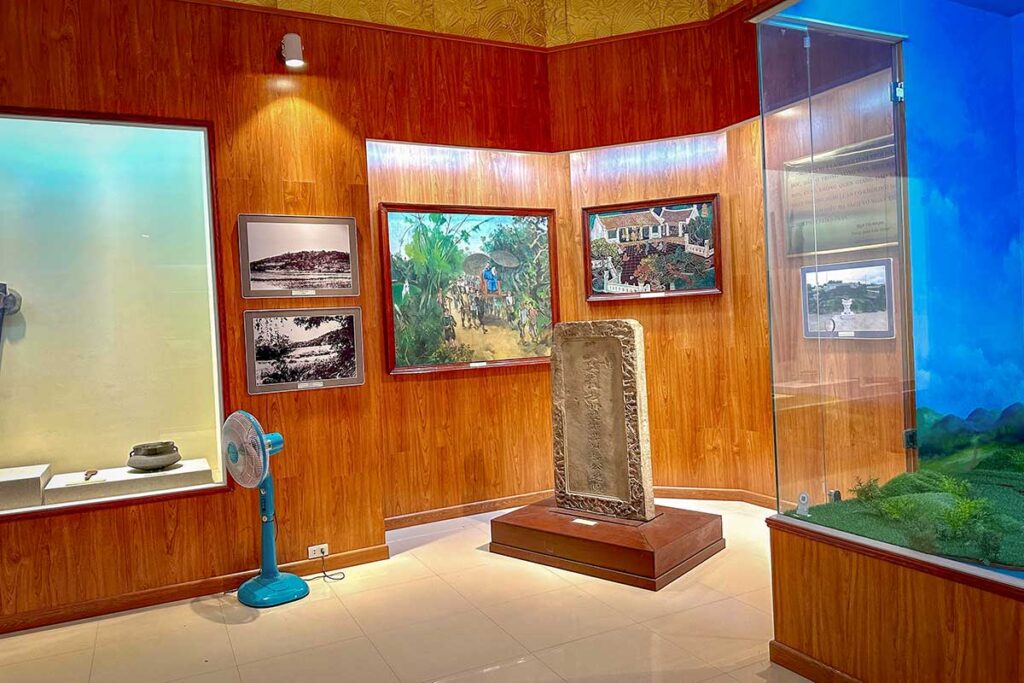
The first part of the exhibition introduces the family background of the Tay Son brothers and the rural conditions that shaped them. You’ll see genealogical records, ancestral worship items, and displays explaining why this part of Binh Dinh became the cradle of the uprising. It sets the stage for how three brothers from a farming family turned a local rebellion into a nationwide movement.
2. Military campaigns and relics

This section highlights the battles that made Quang Trung famous. Large maps and painted murals illustrate the campaigns, especially the legendary victory against the Qing army in 1789.

Cases of weapons, swords, spears, and cannons show what the Tay Son army fought with, and one of the standout objects is the elephant-skin battle drum, once used to rally troops on the battlefield. These military relics are the most dramatic part of the museum, and while the displays are somewhat traditional, they give a real sense of the uprising’s scale.
3. Governance and Legacy
The Tay Son brothers weren’t just rebels — they ruled as a dynasty, however short-lived. Here you’ll find imperial seals, royal edicts, and administrative documents that reflect their attempts to centralize authority and manage the country.

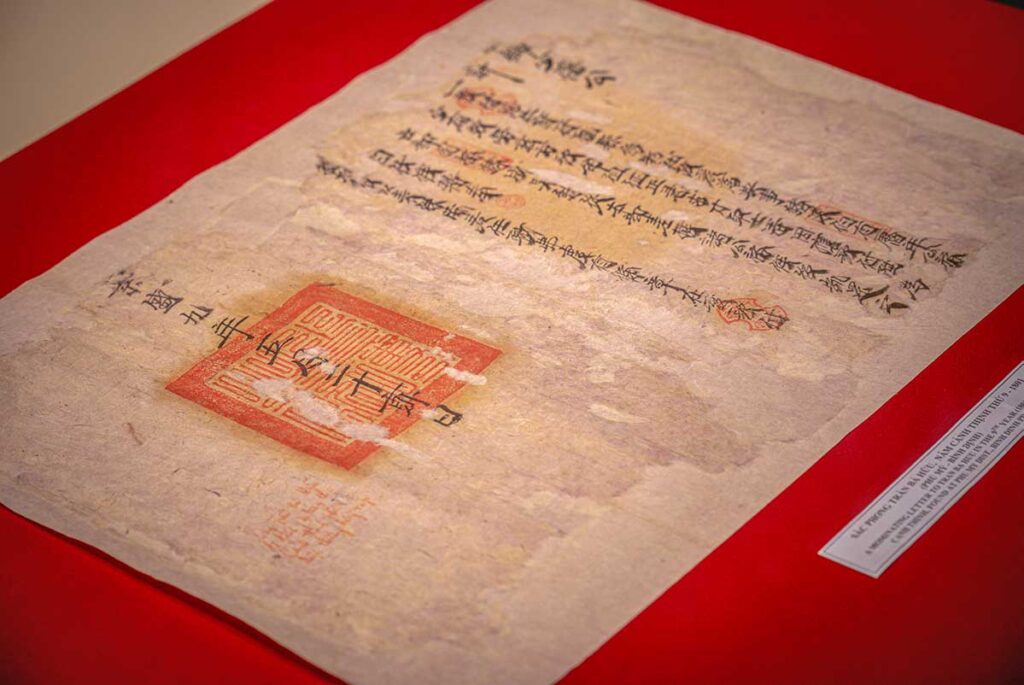
Alongside these are ancestral records, including the tomb stele of their grandfather, discovered much later and now displayed as part of the museum’s narrative about their roots. This section is less eye-catching than the weapons, but it helps visitors understand that the Tay Son movement was as much about state-building as it was about battles.
4. Everyday life and economy
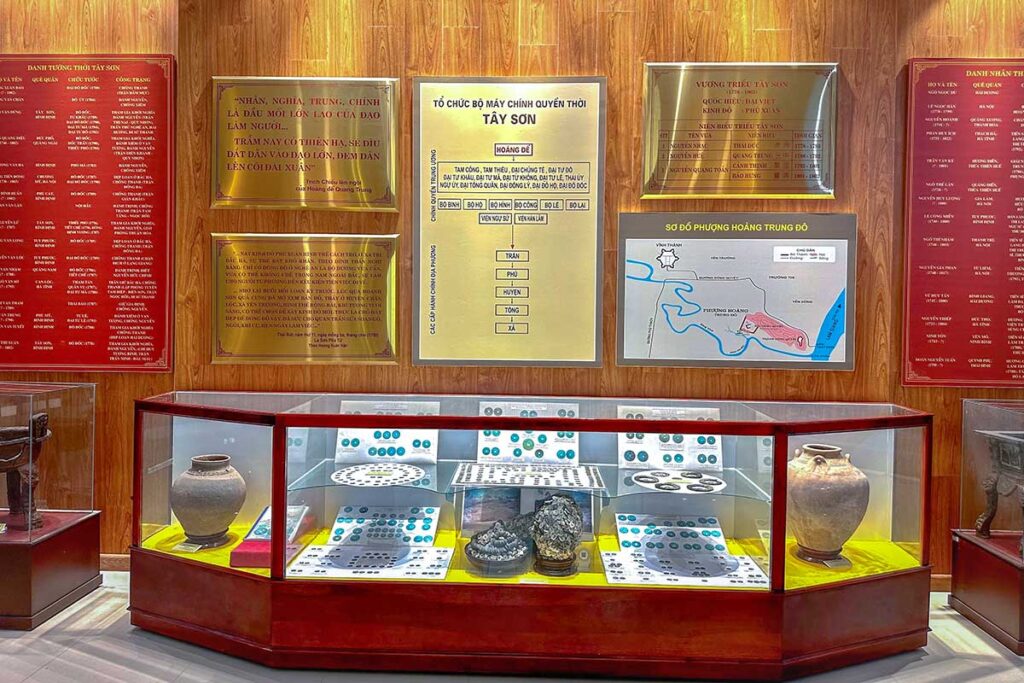
To balance the focus on rulers and armies, the museum also displays objects that represent the daily life of 18th-century Vietnam. Collections of coins, ceramics, farming tools, and household items give a picture of how ordinary people lived during the Tay Son period. While these are not unique to this museum, they are a reminder that the uprising involved farmers and commoners, not just generals and emperors.
5. Murals and Dioramas

Throughout the exhibition halls, you’ll come across large murals and models depicting scenes of battle, life in the Tay Son stronghold, and the movement’s most important events.

The artistic quality is mixed — some murals feel more didactic than artistic — but they serve as a visual aid if you don’t read Vietnamese. These displays make the museum more accessible, even if you’re not a history specialist.
Other things of interest on the museum grounds
1. Quang Trung Statue

At the front of the museum grounds stands a large bronze statue of Emperor Quang Trung. It’s the first thing you notice when entering the complex and sets the tone for the visit. While it doesn’t have the historical weight of the shrine or the artifacts inside, it serves as a symbolic centerpiece that reflects how modern Vietnam continues to honor his legacy.
2. Tay Son Tam Kiet Temple and Ancestral Shrine
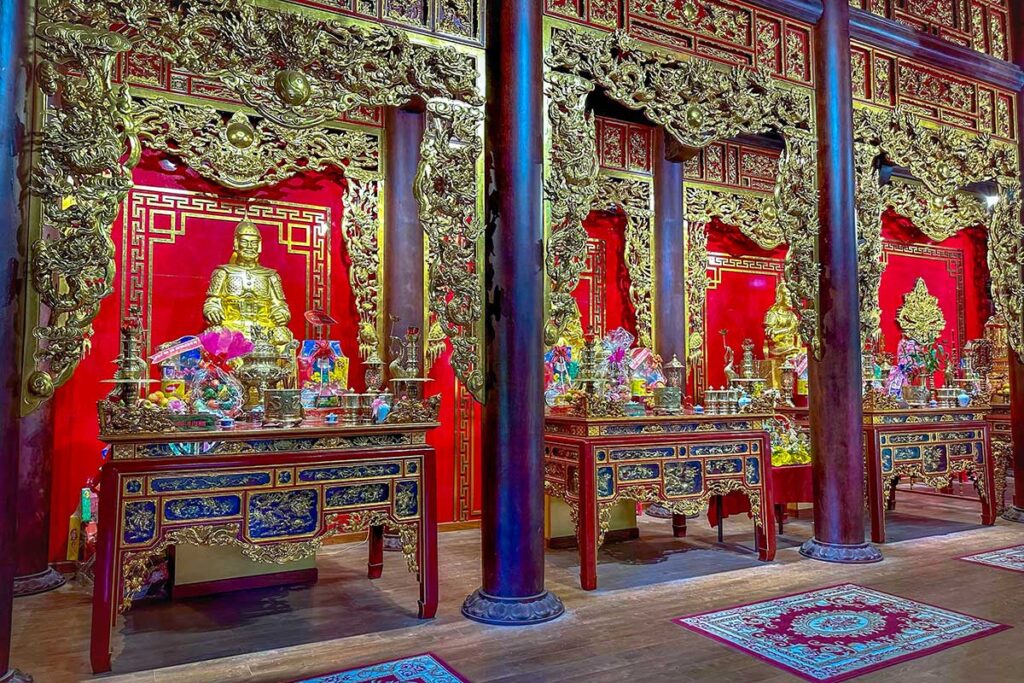
At the heart of the museum grounds stands the Tay Son Tam Kiet Temple, built on the site of the brothers’ former home. Inside, you’ll find ten altars: one for the ancestors, one for the three brothers, several for their generals, and even one dedicated to the Nguyen dynasty that later took power. The temple itself is modest compared to some grand Vietnamese shrines, but its historical significance is immense. In 2014, it was officially recognized as a national special relic, making it an important place of remembrance.
3. The Tamarind Tree and Ancient Well
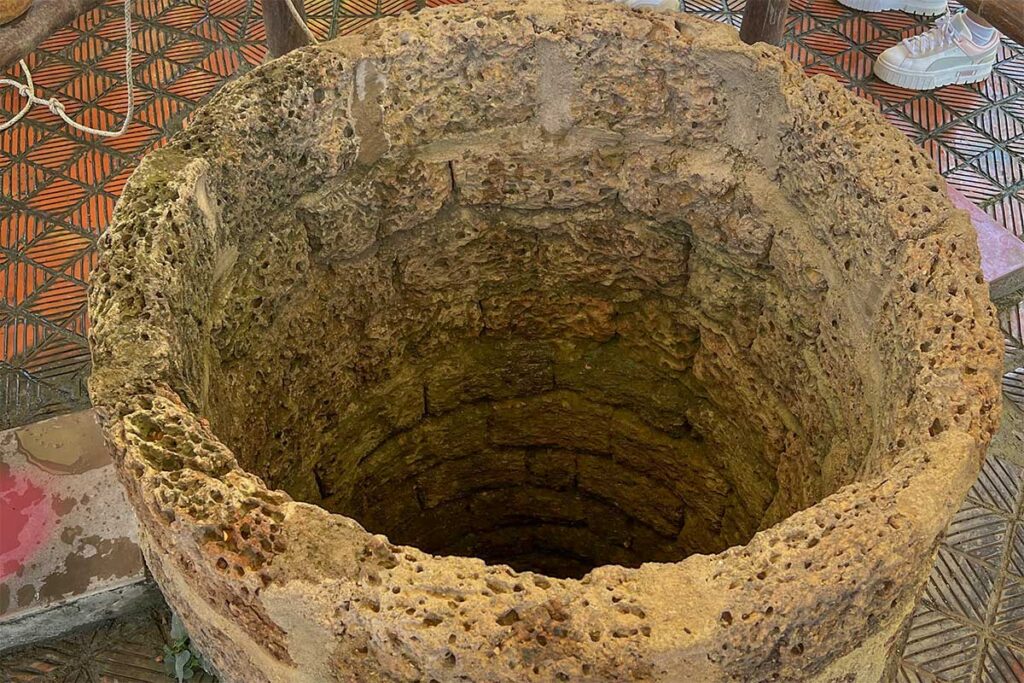
Just outside the shrine, two living relics catch the eye: a 300-year-old tamarind tree and an ancient village well. Both are tied to stories about the Tay Son era. The tamarind tree, still healthy, is seen as a symbol of vitality and resilience, while the laterite-lined well once provided drinking water for the entire hamlet. For visitors, these are simple but memorable reminders that history isn’t only preserved in objects behind glass—it’s also alive in the landscape.
4. Tay Son Martial Arts & Battle Drum Performances
One of the more dynamic experiences at the museum is the martial arts and drum performance. The martial arts routines feature 18 weapon forms, passed down through centuries of Binh Dinh martial arts tradition. Accompanying them is the unique Tay Son battle drum performance, divided into three stages: the departure for battle, the siege, and the victory celebration. It’s both cultural and theatrical, and while it may feel staged for tourists, it’s rooted in real historical practices that boosted morale during wartime.
5. Gong and Ethnic Highland Performances
The museum also highlights the cultural diversity of Vietnam’s central region. On certain days, you can watch gong performances by ethnic groups such as the Ba Na, Jarai, and Cham H’roi.

These are usually paired with a visit to the Nha Rong, a communal stilt house representing Central Highland culture. It’s not the main draw of the museum, but it adds a layer of cultural context, showing how the Tay Son movement drew support from many communities across the region.
Location & Getting there
Where Is Quang Trung Museum?
The museum is located in Phu Phong Town, Tay Son District, about 45 kilometers west of Quy Nhon. It was built here because this area is the birthplace of the Tay Son brothers, making the site historically significant rather than just a random location. The drive out passes through countryside and small towns, giving you a glimpse of rural Binh Dinh along the way.
Taxi or Grab
A taxi or Grab car from Quy Nhon takes around 40–45 minutes. Drivers are usually happy to wait while you visit, but it’s important to agree on the waiting time and return fare in advance. Without that, you may find it hard to arrange transport back, since ride-hailing apps aren’t always available this far outside the city.
Car with driver
For many visitors, hiring a car with driver is the easiest option. It’s more practical than a taxi because you can set a fixed itinerary and combine the museum with other sights in Binh Dinh. This way you don’t need to worry about return trips, and the cost is predictable. It’s also the more comfortable choice if you’re traveling as a couple, family, or small group.
Riding a motorbike
If you’re looking for some independence, riding a motorbike from Quy Nhon is possible. The journey takes about an hour, and while the roads are generally calm, you’ll share them with buses and tour vans, especially near the highway. Officially, foreign travelers need an international driving permit (IDP) to ride legally in Vietnam. The ride isn’t particularly scenic compared to coastal or mountain roads, but it does give you flexibility to explore at your own pace.
Practical visitor information & Tips
Opening Hours
The museum is open daily from 7:00–11:30 in the morning and 13:30–17:00 in the afternoon. Like many cultural sites in Vietnam, it closes for a lunch break in between, so plan your timing accordingly.
Entrance Fees
Admission is affordable: 50,000 VND for adults and 25,500 VND for children aged 6–15 or the elderly. Entry is free for children under 6 and people with disabilities. Tickets are straightforward to buy at the entrance gate.
Facilities
Parking is available directly outside the complex: about 3,000 VND for a motorbike and 15,000–20,000 VND for a car, depending on size. Performances of Tay Son martial arts and drum music can be arranged on-site for an additional fee: 400,000 VND per session for small groups, or 20,000 VND per person if arranged as part of a larger group.
Time needed
This is not a quick in-and-out stop. With nine galleries, a temple, outdoor relics, and the option of performances, the museum is larger than many expect. Allow at least two hours, or up to 2.5 hours if you want to see a martial arts show.
Practical considerations
- Language: Most exhibit labels are in Vietnamese, and the English app isn’t always available, so the experience can feel limited without some prior knowledge or a guide.
- Closures: Occasionally, parts of the complex (like the temple or smaller halls) may be closed without notice.
- Dress: Wear modest clothing if you plan to enter the temple areas—avoid shorts or sleeveless tops.
- Comfort: The museum is air-conditioned in parts, which makes it a more comfortable visit compared to many other provincial museums in Vietnam.
Nearby sights & Suggested combos
The Quang Trung Museum sits inland, about 45 km from Quy Nhon, in a part of Binh Dinh where there aren’t many tourist attractions around. This means the museum is rarely a standalone trip—it makes more sense to combine it with other stops along the way or turn it into a full-day outing. If you’re heading between Quy Nhon and the Central Highlands (Pleiku or Kon Tum), it also works as a convenient cultural stop.
Tay Son Heaven Forum (Vo Truong Toan Temple)
Roughly 10 km from the museum, this temple honors Vo Truong Toan, the teacher of the Tay Son brothers. It’s a small, quiet site without much infrastructure, but if you’ve already made the effort to come out here, it can add a bit more historical context to your visit.
Banh It Towers
On the road from Quy Nhon toward the museum, the Banh It Cham Towers make a great addition. They’re set on a hill with wide countryside views and are among the best-preserved Cham monuments in the province. Stopping here helps break up the drive and adds a completely different layer of history to your day.
Duong Long Cham Towers
Located not too far from Tay Son District, the Duong Long Towers are another worthwhile Cham site. These are some of the tallest Cham towers in Vietnam and are impressive for both their scale and decorative detail. If you’re already heading inland, they can be combined with the museum without too much detour.
On the Way Routes
For those traveling overland between Quy Nhon and Pleiku/Kon Tum, the museum is directly on the route, making it a logical cultural stop. For visitors based only in Quy Nhon, however, it works best as part of a longer day trip that mixes the museum with Cham towers or countryside stops, rather than going there and back just for the museum alone.
Is Quang Trung Museum worth visiting?
For Vietnamese visitors, the museum holds deep meaning as both a memorial to Quang Trung and a source of cultural pride. It’s a place where history and respect for the Tay Son brothers are strongly felt.
For foreign travelers, the experience depends a lot on your interests. If you’re drawn to Vietnamese history, military strategy, or martial arts, it’s worth the effort—there are plenty of artifacts, performances, and historical context to take in. If not, the journey out here (around an hour from Quy Nhon) may feel a bit long for what you get.
The museum itself is large, well-maintained, and more substantial than many provincial museums, but the lack of consistent English explanations can make it harder to fully appreciate without some prior reading or a guide.
Overall, the museum works best as part of a full-day trip inland, ideally paired with Cham towers like Banh It or Duong Long, or with stops in the Quy Nhon countryside. On its own, it may not justify the journey unless you have a strong personal interest in the Tay Son period.



